The harsh Russian winter makes everyone think about insulating their home. And if the happy owners of apartments with centralized heating can shift their worries onto the mighty shoulders of utility companies, residents of so-called private houses have to solve problems on their own. There are many heating options. However, among the various heating systems for the home, water heating is most often chosen as the most practical and traditional option.
How is a water heating system arranged?
The principle of operation of hot water heating is quite simple. The design is a closed system consisting of a heating boiler, piping and radiators.
The boiler heats up the coolant, it can be water or a solution based on one of the glycols, which flows through pipes to the radiators located in the heated room. The batteries heat up and release heat into the air, due to which the room itself heats up. The cooled coolant returns through the pipes to the boiler, where it heats up again and the cycle repeats.
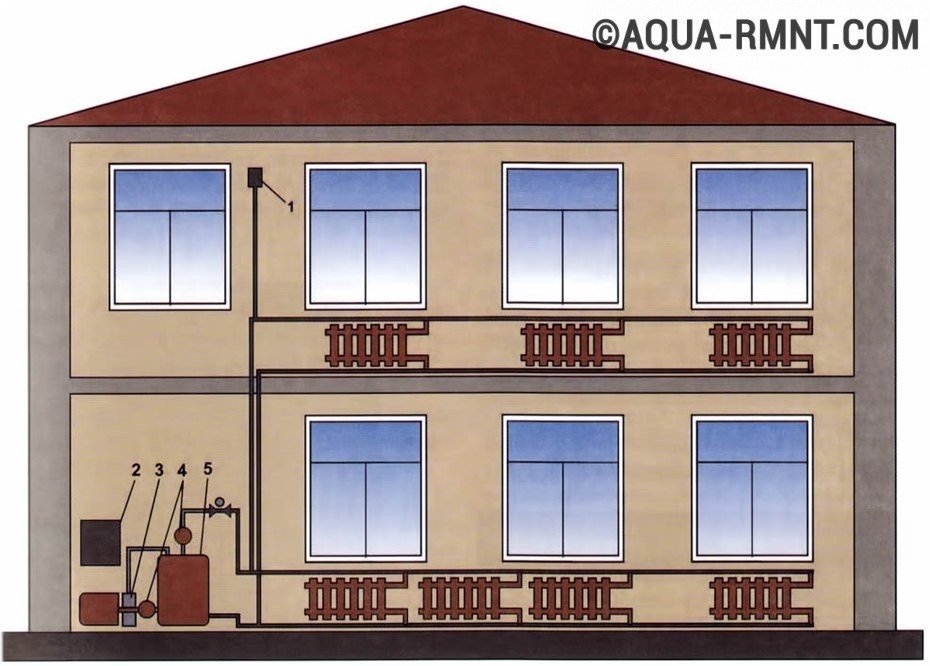
Water heating is a closed system in which the coolant circulates: 1 - expansion tank; 2-automatic control unit; 3-vortex generator; 4 - circulation pump; 5-tank thermos
The circulation of the coolant, on which all hot water heating systems are based, can be carried out in two ways - natural and forced.
Option # 1 - natural or gravity
The process is carried out at the expense of different densities of cold and hot water. The heated liquid becomes less dense and, accordingly, weighs less, therefore it tends upward, moving along the pipes. Cooling down, it becomes denser, after which it returns to the boiler.

The natural circulation system works by the action of natural forces of gravity
The main advantage is considered autonomy, since it does not depend on electricity, and the extreme simplicity of the design. The disadvantages include the need to use a large number of pipes, and their diameter must be large enough to ensure natural circulation. As well as the inability to use modern models of batteries with a small cross-section and the need to strictly adhere to a slope of at least 2 °.
Option # 2 - forced system
The movement of the coolant through the pipes occurs due to work. The excess liquid formed during heating is discharged into a special expansion tank, most often closed, which prevents the evaporation of water from the system. If a glycol solution is chosen as the heat carrier, the expansion tank must be closed without fail. In addition, the system has a pressure gauge that monitors pressure.
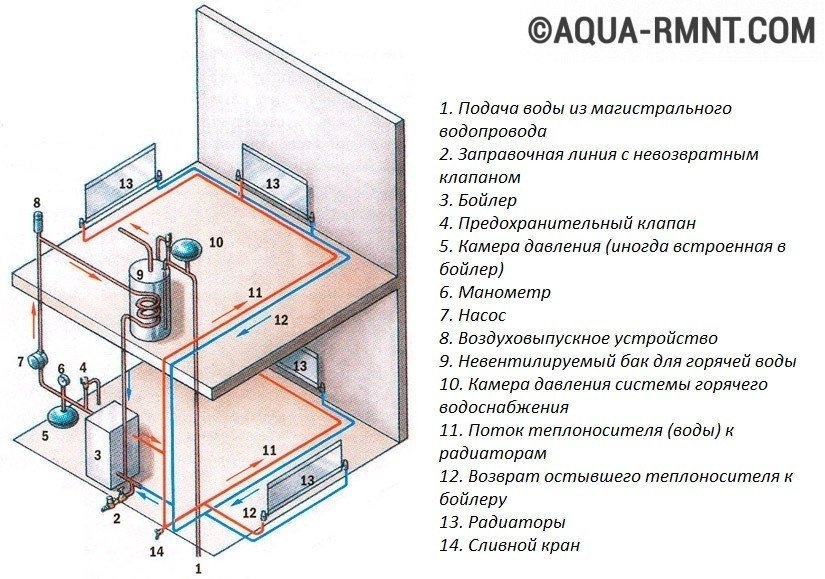
The forced system implies additional costs for an expansion tank, pressure gauge, pump, thermostats, etc.
The advantages of the design are undeniable: a small volume of the coolant, which can be used not only for water, a smaller flow rate of pipes, the diameter of which is smaller than in the previous case. The ability to regulate the heating temperature of radiators, batteries can be of any type with any pipe diameter. The main disadvantage is the dependence on the supply of electricity, with the help of which the pump operates.
A more detailed comparison of these two options can be seen in this video:
Devices required for system operation
A home water heating system will function smoothly only if its main components are correctly selected.
Boiler for heating the coolant
Practice shows that it can be of any type: gas, electric, liquid or solid fuel. The most economical models are those that run on gas. However, they require a gas pipeline connection, regular monitoring and maintenance by specialists. Solid or liquid fuel assumes complete independence of heating from centralized networks, but will require the arrangement of a special storage facility for fuel supplies.
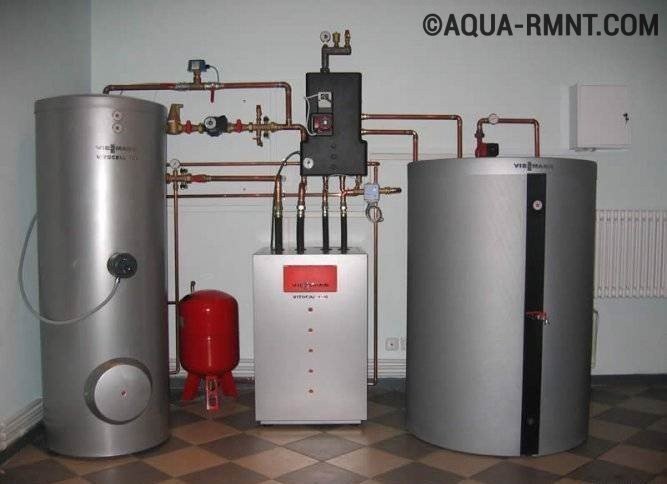
The boiler is most often installed either in the basement of the house, or in a specially equipped room - the boiler room
An electric boiler must be connected to the mains and consumes a fairly large amount of energy. This option is generally not advisable, since it is easier to install electric radiators and directly convert electricity into heat.
The power of the equipment is selected based on the area of the heated room. On average, in order to equip water heating at home, a boiler with a capacity of 1 kW per 10 square meters is selected. meters with a wall height of no more than 3 m. It is also worth considering the degree of home insulation, the size of the windows and the presence of possible additional heat consumers.
Pipes that make up the heating circuit
Traditionally, they were made of metal. But welded steel structures are easily corroded. Therefore, they were replaced by galvanized and stainless steel pipes, which do not have this drawback. The most reliable metal option is copper pipes, which can withstand pressure drops, temperatures and are not subject to corrosion. They can simply be "hidden" in the walls of the house. However, the high cost of such equipment makes it an exclusive option.
They have good performance characteristics. They are durable, do not corrode, are easy to install, and no deposits are deposited on their inner surfaces. The only drawback: a high coefficient of thermal expansion, which provokes damage to the pipe during temperature extremes.
Analysis of classic layouts
It should be noted that water heating of a country house can be equipped in different ways. Distinguish between single-circuit and double-circuit systems. The first is intended exclusively for heating rooms.
It consists of a single-circuit boiler with atmospheric exhaust, a simple one-pipe wiring and the required number of radiators. In order to provide hot water supply, two such structures can be installed simultaneously. In this case, one will carry out heating, and the second will heat the water. Which is quite practical, since in the warm season it will be possible to use only water heating.
The design is considered the most inexpensive and easiest to install, best suited for houses whose area is less than or equal to 100 square meters. m. This is probably why it is often used to equip water heating in the country. It can be improved by adding a circulation pump, two-pipe wiring and thermostats on the radiators.
The double-circuit design is used for heating and hot water supply. It is especially convenient in houses with no more than 4 people. Another nuance: the water must be tap water or specially softened, hard water directly from the well will not work.
Based on the principle of movement of the coolant, the system can be one-pipe, two-pipe and collector. Let's consider each of them in more detail.
Option # 1 - one pipe system
The coolant sequentially passes from the first battery to the next. In this case, the temperature of each subsequent radiator will be slightly lower. The very last may no longer have enough heat to heat the room sufficiently.
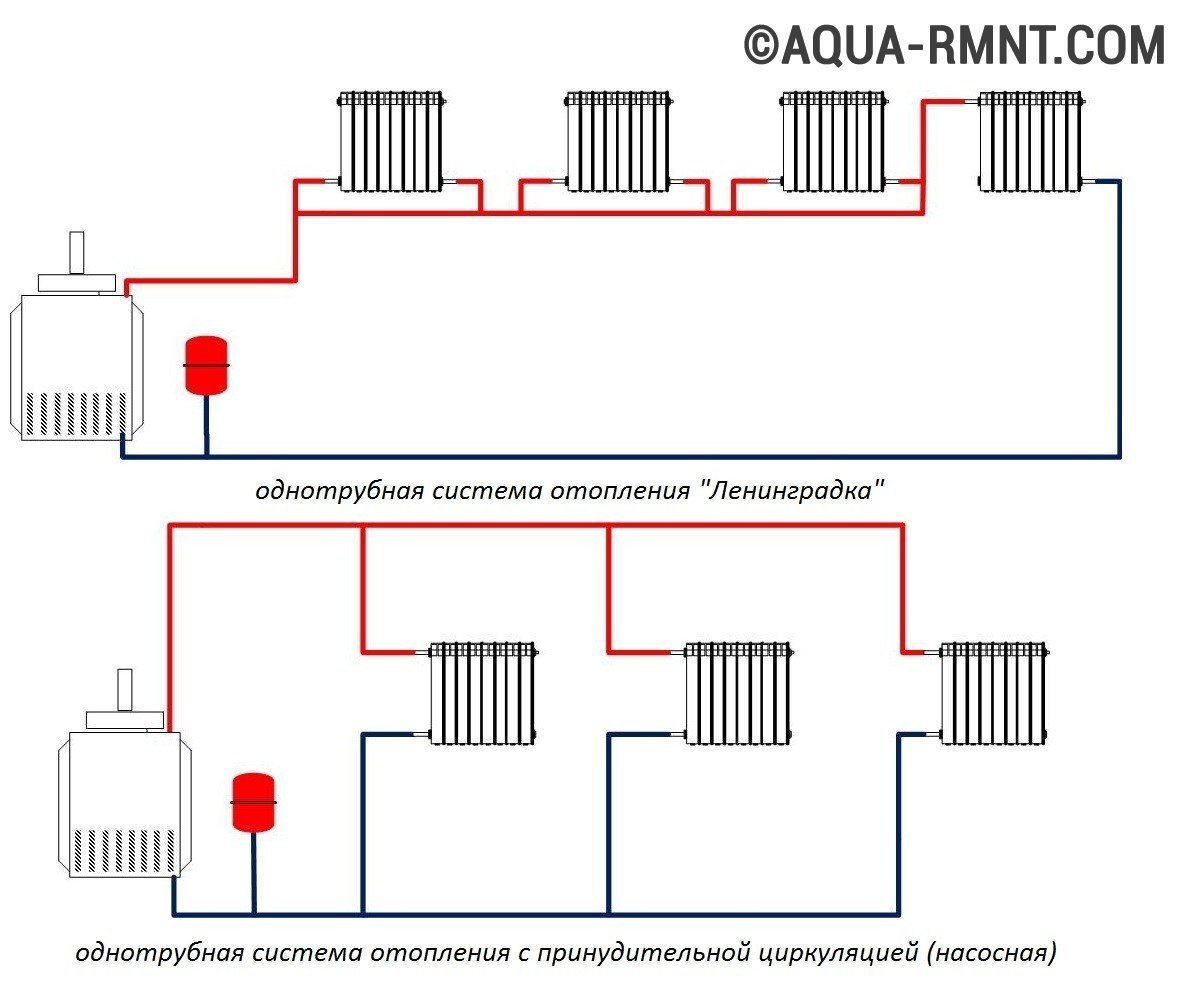
The one-pipe system is practically unregulated, since a closed battery will close the access of liquid to all others
If it is necessary to repair the radiator, you will have to drain the coolant from the system and only after that you can manipulate the failed device.
Option # 2 - two-pipe system
This scheme warms up the room better. It assumes the presence of two pipes suitable for each battery. Through one of them, the heated liquid enters the radiator, and with the help of the other it is discharged after cooling.
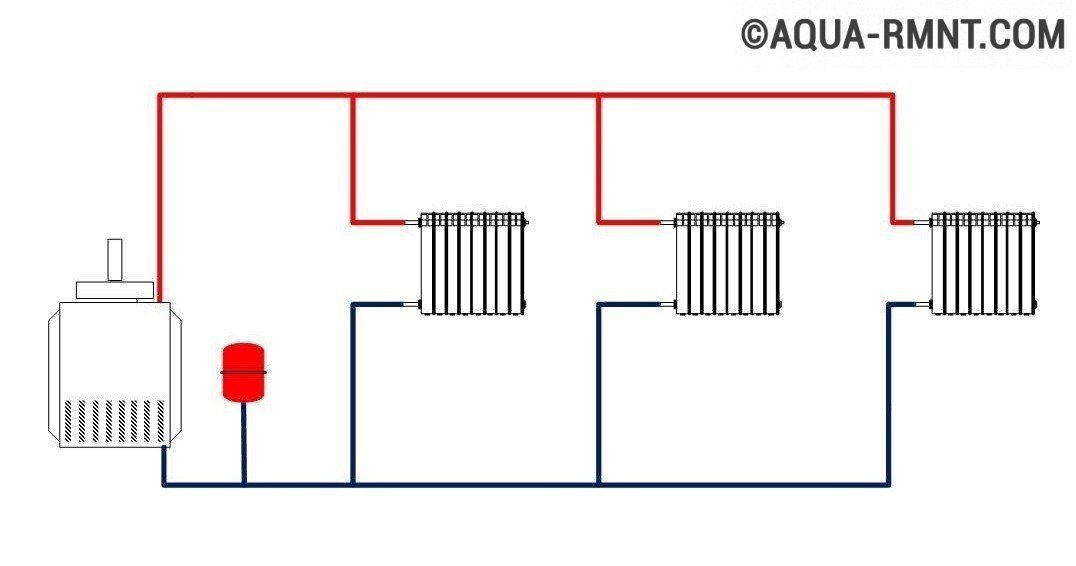
A distinctive feature of such a system: pipes with a hot coolant are connected to radiators in parallel, which makes it possible, if necessary, to disconnect the batteries
As in the previous version, in the last heatsink the temperature will be slightly lower, but the losses in this case are insignificant.
Option # 3 - manifold wiring
The most convenient system to use, assuming the presence of a collector, from which a pipe with a hot coolant fits separately to each of the radiators and another one returns the cooled liquid. It makes it possible to regulate the temperature in the room, repair or replace any part of the system without first turning off the heating. The main disadvantage: high pipe consumption and the need to install a manifold cabinet.



